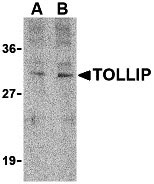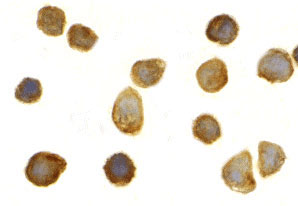TOLLIP Antibody
- 产品详情
- 实验流程
- 背景知识
Application
| WB, ICC, E |
|---|---|
| Primary Accession | Q9H0E2 |
| Other Accession | AAH18272, 17390641 |
| Reactivity | Human, Mouse, Rat |
| Host | Rabbit |
| Clonality | Polyclonal |
| Isotype | IgG |
| Calculated MW | 30282 Da |
| Concentration (mg/ml) | 1 mg/mL |
| Conjugate | Unconjugated |
| Application Notes | TOLLIP antibody can be used for the detection of TOLLIP by Western blot at 1 - 2 µg/mL. Antibody can also be used for immunocytochemistry starting at 2 µg/mL. |
| Gene ID | 54472 |
|---|---|
| Other Names | TOLLIP Antibody: IL-1RAcPIP, Toll-interacting protein, toll interacting protein |
| Target/Specificity | TOLLIP; |
| Reconstitution & Storage | TOLLIP antibody can be stored at 4℃ for three months and -20℃, stable for up to one year. As with all antibodies care should be taken to avoid repeated freeze thaw cycles. Antibodies should not be exposed to prolonged high temperatures. |
| Precautions | TOLLIP Antibody is for research use only and not for use in diagnostic or therapeutic procedures. |
| Name | TOLLIP |
|---|---|
| Function | Component of the signaling pathway of IL-1 and Toll-like receptors (PubMed:10854325, PubMed:11751856). Inhibits cell activation by microbial products. Recruits IRAK1 to the IL-1 receptor complex (PubMed:10854325). Inhibits IRAK1 phosphorylation and kinase activity (PubMed:11751856). Connects the ubiquitin pathway to autophagy by functioning as a ubiquitin-ATG8 family adapter and thus mediating autophagic clearance of ubiquitin conjugates (PubMed:25042851). The TOLLIP-dependent selective autophagy pathway plays an important role in clearance of cytotoxic polyQ proteins aggregates (PubMed:25042851). In a complex with TOM1, recruits ubiquitin-conjugated proteins onto early endosomes (PubMed:15047686). Binds to phosphatidylinositol 3-phosphate (PtdIns(3)P) (PubMed:26320582). |
| Cellular Location | Cytoplasm. Endosome. Early endosome Note=Localized to endo/exosomal vesicles |
For Research Use Only. Not For Use In Diagnostic Procedures.
Provided below are standard protocols that you may find useful for product applications.
BACKGROUND
TOLLIP Antibody: Toll-like receptors (TLRs) are evolutionarily conserved pattern-recognition molecules resembling the toll proteins that mediate antimicrobial responses in Drosophila. These proteins recognize different microbial products during infection and serve as an important link between the innate and adaptive immune responses. The TLRs act through adaptor molecules to activate various kinases and transcription factors so the organism can respond to potential infection. These adaptor molecules include TOLLIP, MyD88, and TRIF. TOLLIP associates directly with TLR2 and TLR 4, acting as an inhibitor to TLR activation. This negative regulation of TLR signaling may serve to limit the production of proinflammatory mediators during infection and inflammation.
REFERENCES
Takeda K, Kaisho T, and Akira S. Toll-like receptors. Annu. Rev. Immunol.2003; 21:335-76.
Janeway CA Jr. and Medzhitov R. Innate immune recognition. Annu. Rev. Immunol.2002; 20:197-216.
McGettrick AF and O’Neill LAJ. The expanding family of MyD88-like adaptors in Toll-like receptor signal transduction. Mol. Imm.2004; 41:577-82.
Zhang G and Ghosh S. Negative regulation of Toll-like receptor-mediated signaling by Tollip. J. Biol. Chem.2002; 277:7059-65.
终于等到您。ABCEPTA(百远生物)抗体产品。
点击下方“我要评价 ”按钮提交您的反馈信息,您的反馈和评价是我们最宝贵的财富之一,
我们将在1-3个工作日内处理您的反馈信息。
如有疑问,联系:0512-88856768 tech-china@abcepta.com.























 癌症的基本特征包括细胞增殖、血管生成、迁移、凋亡逃避机制和细胞永生等。找到癌症发生过程中这些通路的关键标记物和对应的抗体用于检测至关重要。
癌症的基本特征包括细胞增殖、血管生成、迁移、凋亡逃避机制和细胞永生等。找到癌症发生过程中这些通路的关键标记物和对应的抗体用于检测至关重要。 为您推荐一个泛素化位点预测神器——泛素化分析工具,可以为您的蛋白的泛素化位点作出预测和评分。
为您推荐一个泛素化位点预测神器——泛素化分析工具,可以为您的蛋白的泛素化位点作出预测和评分。 细胞自噬受体图形绘图工具为你的蛋白的细胞受体结合位点作出预测和评分,识别结合到自噬通路中的蛋白是非常重要的,便于让我们理解自噬在正常生理、病理过程中的作用,如发育、细胞分化、神经退化性疾病、压力条件下、感染和癌症。
细胞自噬受体图形绘图工具为你的蛋白的细胞受体结合位点作出预测和评分,识别结合到自噬通路中的蛋白是非常重要的,便于让我们理解自噬在正常生理、病理过程中的作用,如发育、细胞分化、神经退化性疾病、压力条件下、感染和癌症。







